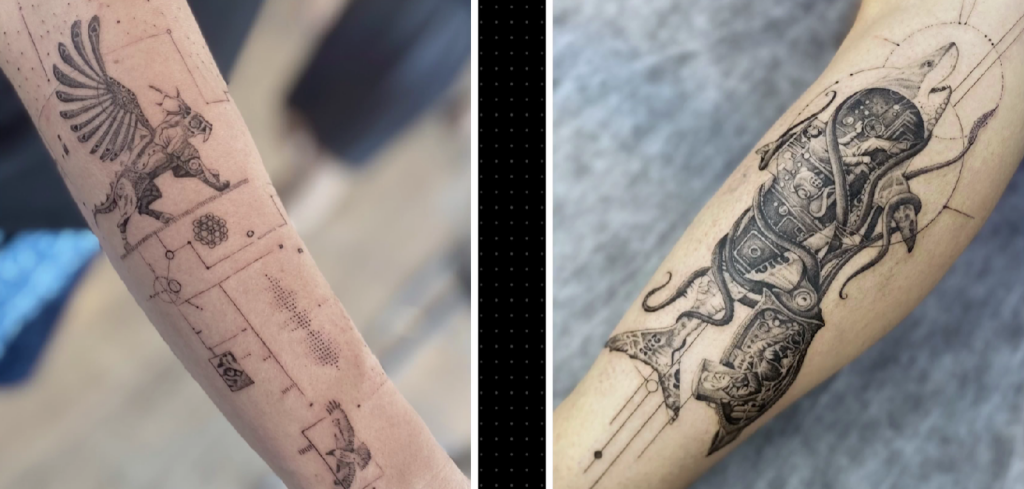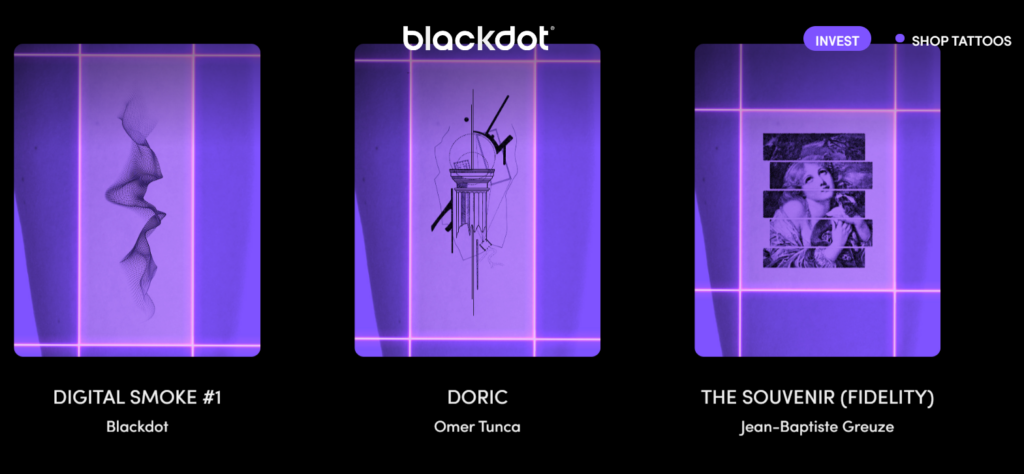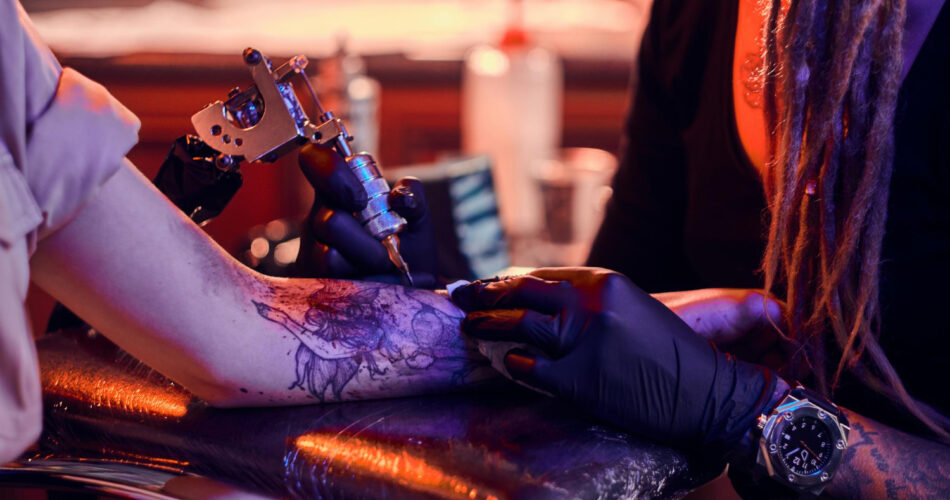We have meticulously reviewed the intricate dance between art and technology that is unfolding in the world of NFT tattoos. We’ve delved deep, unraveling the threads of innovation and creativity, to bring you an insightful gaze into this revolutionary art form.
Table of Contents
Unraveling the Enigma of NFT Tattoos
In the vibrant intersection where art meets technology, NFT tattoos emerge as a mesmerizing dance of pixels and ink. But what exactly are they? At their core, NFT tattoos are a groundbreaking fusion of traditional tattoo artistry with the digital realm of non-fungible tokens (NFTs).
NFTs, or non-fungible tokens, represent a unique digital asset verified using blockchain technology. Unlike cryptocurrencies such as Bitcoin or Ethereum, which are fungible and can be exchanged on a one-for-one basis, NFTs are distinct and cannot be exchanged on a like-for-like basis. This uniqueness and the ability to verify authenticity make NFTs particularly appealing for artists and creators.
Now, imagine taking this digital uniqueness and merging it with the age-old art of tattooing. The result is an NFT tattoo. Every design, every line, every shade is not just inked on the skin but is also immortalized on the blockchain. This means that the bearer doesn’t just wear a piece of art; they also hold a digital asset, a one-of-a-kind token that represents their tattoo.
But the magic doesn’t stop there. The introduction of specialized machines, capable of inking these blockchain-stored designs, has further elevated the experience. These machines ensure precision, capturing the artist’s vision perfectly, and then translating it into a digital token that can be owned, traded, or even sold.
A Journey Through Time: The Evolution of Tattoo Artistry
Tattoos have been a part of human culture for millennia, serving as symbols of identity, rites of passage, or simply as forms of self-expression. From ancient tribal markings to modern digital innovations, the art of tattooing has undergone a fascinating transformation, mirroring the evolution of human society and its ever-changing values and aesthetics.
Detailed Timeline Chart: The Evolution of Tattoo Artistry
| Time Period | Tattoo Style & Characteristics | Cultural Significance & Notable Facts |
|---|---|---|
| Ancient Times | Tribal and Symbolic Tattoos | Used by ancient civilizations like the Egyptians and Polynesians as symbols of status, religion, and protection. |
| Middle Ages | Religious and Pictorial Tattoos | Tattoos were less common in Europe but flourished in Asia. They often had religious significance or were used to mark criminals. |
| 18th Century | Nautical and Traditional Tattoos | Sailors began getting tattoos as mementos of their travels. Iconic symbols like anchors and swallows became popular. |
| Late 19th – Early 20th Century | Old School Tattoos | Characterized by bold lines and limited color palette. Common motifs included hearts, roses, and birds. |
| 1970s – 1990s | Tribal, Blackwork, and New School Tattoos | A resurgence of tribal tattoos, influenced by indigenous cultures. New School tattoos with vibrant colors and exaggerated illustrations also emerged. |
| 2000s | Realistic, Watercolor, and Geometric Tattoos | Techniques improved, allowing for photorealistic tattoos. Watercolor tattoos without black outlines became popular. |
| 2010s – Present | Minimalistic, Dotwork, and Biomechanical Tattoos | A trend towards simpler designs, intricate dot patterns, and tattoos that integrate with the body’s anatomy. |
| Digital Age | NFT Tattoos | The pinnacle of tattoo evolution, where designs are stored on the blockchain, doubling as digital assets and physical art. |
The Allure of Benefits: Why NFT Tattoos?

A New Revenue Stream for Artists
In the traditional art world, artists often receive a one-time payment for their work. With NFT tattoos, every time the digital asset changes hands or is used in a new way, the original artist can receive a royalty. This continuous revenue model ensures that artists are compensated fairly for the ongoing popularity and use of their designs.
Authenticity and Provenance
One of the significant challenges in the digital realm is the ease with which artworks can be copied or replicated. NFT tattoos, stored on the blockchain, come with a guarantee of authenticity. Each tattoo is associated with a unique digital token, ensuring that the artwork’s origin and ownership lineage are traceable and indisputable.
Dual Ownership: Physical and Digital

An NFT tattoo is not just a piece of art on the skin; it’s also a digital asset. The bearer of the tattoo not only showcases a unique design on their body but also holds a digital token representing that design on the blockchain. This duality offers a blend of physical artistry with digital ownership, allowing individuals to engage with their tattoos in innovative ways, such as showcasing them in virtual galleries or even trading them in digital marketplaces.
Immortality on the Blockchain
While traditional tattoos last as long as the skin they’re inked on, NFT tattoos have an immortal digital counterpart. Even if the physical tattoo fades or is altered, its digital version remains pristine and unchanged on the blockchain, serving as a timeless testament to the art and the moment it represents.
The Symphony of Creation: Getting an NFT Tattoo

In the vast expanse of tattoo artistry, Blackdot emerges as a beacon of innovation, pushing the boundaries of what’s possible and redefining the tattoo experience. This isn’t just about getting a tattoo; it’s about immersing oneself in a world where art, science, and technology converge.
The Pinnacle of Precision: Blackdot’s Technological Marvel
Blackdot‘s tattoo machine is not just any device; it’s a symphony of advanced mapping, motion systems, and biocompatible technology. Designed to treat the skin as the ultimate canvas, it ensures unprecedented detail and precision, bringing the ancient art of tattooing into the modern era. This fully automated, scalable platform offers capabilities beyond the human hand, with a grayscale range so wide and dots so fine they’re roughly the diameter of a human hair.
An Immersive Experience: Where Art and Science Intersect
Blackdot’s studios are designed to maximize comfort, safety, and hygiene. As you relax in a futuristic setting, you’re surrounded by wonder, working with a team that truly listens. The technology ensures a swift and predictable tattooing process, minimizing discomfort and maximizing possibilities for both artists and tattoo enthusiasts.
Beyond Traditional Boundaries: Unlocking New Artistic Horizons
What was once off-limits in tattooing—fine art, code-driven and generative art, rare street art, and legendary cover art—is now accessible, thanks to Blackdot’s powerful technology. This opens up a realm of possibilities, allowing renowned artists and illustrators to express their artwork on the most demanding canvas—skin.
The Blackdot Gallery: A New World of Expression and Choice

Blackdot isn’t just about the technology; it’s about the art. The Blackdot Gallery is the world’s first transactional hub for physically executed digital tattoo art. Tattoo seekers can enjoy unparalleled freedom and flexibility, acquiring tattoos through traditional payment methods or collecting tattooable digital art as Tradable Tattoos™. This offers both artists and tattoo enthusiasts more choices than ever before.
The Silent Echoes of Concern

As the world stands on the cusp of a new era, where artistry meets digital innovation in the form of NFT tattoos, there are underlying concerns that ripple beneath the surface. These concerns, rooted in ethics, technology, and societal implications, beckon for a closer examination.
The Ethical Landscape: Ownership, Rights, and Artistic Integrity
The Dual Ownership Paradox
When one’s skin becomes both a canvas and a tradable digital asset, questions of true ownership emerge. If the digital version of a tattoo is sold, does the skin-bearer retain any rights or say in its future transactions? The intertwining of personal autonomy with digital commerce presents a unique ethical conundrum.
Artistic Integrity in a Digital World
With the ability to replicate digital assets, there’s a looming concern about preserving the originality and intent of the artist. How can we ensure that the essence of the artwork isn’t diluted or misrepresented in the vast expanse of the digital realm?
Technological Challenges: Security, Authenticity, and Sustainability
Safeguarding Digital Assets
As tattoos transition into the realm of digital assets, the threat of hacking, unauthorized duplication, and potential misuse becomes real. Ensuring robust cybersecurity measures is paramount to protect the sanctity and value of these unique digital tattoos.
The Carbon Conundrum of Blockchain
The environmental impact of blockchain technology, particularly in terms of energy consumption, cannot be ignored. As the demand for NFT tattoos grows, the industry must grapple with its carbon footprint and seek sustainable alternatives.
Societal Implications: Privacy, Perception, and Cultural Sensitivities
Navigating the Privacy Minefield
With personal tattoos being minted as public digital assets, concerns about privacy and data protection arise. How does one ensure that personal stories and meanings behind tattoos aren’t exploited or misused?
Cultural Sensitivities and Appropriation
Tattoos often carry deep cultural and symbolic meanings. As they become commodified in the digital space, there’s a risk of cultural appropriation or misrepresentation, potentially diluting or disrespecting the rich tapestries from which they originate.
Gazing into the Future
As the sun sets on today’s technological marvels, the dawn of tomorrow promises even more astounding innovations. The fusion of NFTs and tattoos is just the beginning, a mere glimpse into a future teeming with possibilities and challenges.
The Evolution of Artistic Expression
Beyond the Skin: Augmented Reality (AR) Tattoos
Imagine tattoos that come alive when viewed through AR glasses, adding layers of interactivity and depth to the artwork. NFT tattoos could evolve to include dynamic elements, animations, or even interactive stories that can be experienced in augmented reality.
The Rise of Generative Art Tattoos
Generative art, driven by algorithms and code, could find its way into the world of NFT tattoos. These tattoos would be ever-evolving, changing patterns, colors, or designs based on data inputs, mood, or even environmental factors.
Expanding the Economic Landscape
A New Marketplace for Tattoo Artists
The digital realm could open up vast marketplaces where tattoo artists auction their designs as NFTs. Collectors could acquire these digital assets, either to ink on their skin or to keep as digital art pieces, appreciating in value over time.
Tattoo Rentals and Temporary NFTs
In a future where commitment to a permanent design might wane, individuals could “rent” NFT tattoo designs for a specific duration, after which they fade or transform, allowing for ever-changing body art that aligns with one’s evolving tastes.
Societal and Cultural Shifts
Redefining Identity in the Digital Age
With the ability to carry a unique digital asset on one’s skin, the concept of identity could undergo a transformation. NFT tattoos might become symbols of status, affiliation, or even digital citizenship in online communities.
Navigating Ethical and Cultural Nuances
As NFT tattoos gain popularity, they might spark debates around cultural appropriation, especially if designs with deep cultural significance are commodified. The industry would need to tread carefully, ensuring respect and understanding for the rich tapestries of cultures and traditions.
Conclusion
As we stand at the crossroads of tradition and innovation, the world of NFT tattoos offers a tantalizing glimpse into the future of artistic expression. It’s a realm where the age-old allure of tattoos melds seamlessly with the cutting-edge technology of blockchain, crafting a narrative that’s as profound as it is pioneering.
The journey of NFT tattoos, from their inception to their potential future, is a testament to humanity’s relentless quest for evolution. It’s about pushing boundaries, challenging norms, and redefining what’s possible. But as with all revolutions, it comes with its own set of challenges and concerns. From ethical dilemmas about ownership and autonomy to technological hurdles related to security and sustainability, the path forward is intricate and demands careful navigation.
Yet, amidst these challenges lies immense promise. The fusion of tattoos and NFTs is not just about creating art; it’s about reimagining the very essence of ownership, identity, and expression. It’s about giving artists new avenues to showcase their creativity, offering individuals novel ways to express their individuality, and crafting a future where art transcends physical boundaries to find a home in the vast expanse of the digital realm.
As we conclude this exploration, one thing is clear: NFT tattoos are more than just a trend; they’re a movement. A movement that beckons artists, technologists, and visionaries to come together and shape a future that’s as diverse as it is dynamic. A future where the silent echoes of ink on skin resonate in the boundless corridors of the blockchain, crafting symphonies that will be remembered for generations to come.
FAQs
What is an NFT Tattoo?
An NFT tattoo is a unique blend of physical art and digital ownership, where every design is immortalized on the blockchain.
How are artists benefiting from NFT tattoos?
Artists earn royalties, ensuring their art is not just seen but valued, with every transaction echoing their creativity’s worth.
Are there ethical concerns associated with NFT tattoos?
Yes, questions about ownership, authenticity, and the implications of combining physical and digital realms are still being explored.


